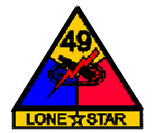 Every unit patch I wore on the left arm of my BDUs is now officially a memory.
Every unit patch I wore on the left arm of my BDUs is now officially a memory.
During my nine-year enlistment in the Army National Guard, I wore two unit patches on my BDUs (granted, it should’ve been three, but my time officially drilling as a member of the D.C. Guard was so brief I never received the Capitol Guardians patch). When I signed up in 1990, the Texas Guard had seven M60-A3 battalions, five in the 49th Lone Star Armored Division and two joined with the New Jersey Guard in the 50th AD. My unit, HHC 7/112th AR, was part of the 50th.
In 1993, the Texas Guard upgraded to M1s but also, as part of the general post-Cold War reduction in force, was reduced to five battalions, all part of the 49th AD. My unit served temporarily as HHC 5/112 before becoming HHC 4/112 AR. Shortly after my return from D.C., I transferred to a line company to become a gunner on an old buddy’s tank. I served out the remainder of my time, including an extended enlistment, in D Co, 5/112 AR. I left the Guard in April 1999. Immediately after that year’s annual training period, D Co was done away with as part of an across-the-board restructuring of armored battalions. My last unit was no more.
Now, albeit well past the actual occurence, I’ve recently found out that the 49th AD is also no more.
“We are transforming our Army to better meet the demands of the 21st century,†said Acting Secretary of the Army Les Brownlee. “Today’s re-flagging from the 49th Armored Division to the 36th Infantry Division is representative of these changes.â€
Brownlee and Texas Gov. Rick Perry attended the unit’s re-flagging ceremony, resulting in the National Guards’ loss of all armored divisions. The Guard Soldiers stood reverently as their commanders changed colors July 18 on Camp Mabry’s parade field in Austin, Texas.
“Transformation is not new to our Army or the Texas National Guard,†said Maj. Gen. Michael H. Taylor, commander of the 36th Inf. Div. “We’ve transformed many times in the past 200 years, especially since World War II. Our job is to stand ready, leave our family and our jobs, augment the active forces to serve our nation. It’s what we do.â€
The 49th was organized after World War II. Since then, it has supported the Berlin crisis, operations in Bosnia, Operation Nobel Eagle and Operation Enduring Freedom.
The 36th “Texas Division†was originally established at Camp Bowie, Fort Worth, Texas, prior to World War I with units formed from Texas and Oklahoma. The patch is a “T†in front of an arrowhead.
“It is a patch worn by thousands before you who stood steadfast for freedom, who placed themselves in harms way for liberty and life,†said Perry.
The 36th Soldiers fought in World War I and it was the first American combat division to land in Europe during World War II. The unit was deactivated in 1968 as part of the Department of the Army program to reduce the number of division-size units.
“Tough days lie ahead,†Perry said. “The work of freedom is a tough duty. But we must keep our eyes on the goal and remember the reason that you set out.â€
By next year, about 4,000 36th Inf. Div. Soldiers will be in Iraq.
“Places change, soldiering stays the same,†said Taylor.
Yes, the 36th ID has a great and storied history. Yes, I may still go back and, if so, I’ll be proud to wear the patch of the 36th. Still, I’ll miss the 49th AD. Farewell, Lone Star.
Comments
2 responses to “Farewell, 49th Lone Star”
It was a sad day for me when the 24th ID was inactivated. You see, I served with the 24th in 1990-1991. The patch on my shoulder (well, technically I don’t wear a uniform anymore) is no longer active :-(. I guess it’s a long winded way of saying “I know how you feel brother”.
I am pleased that you have this website, I acquired a used BDU shirt to use in my work and it had the 49th Lone Star Armored Division patch on the sleeve. I removed the patches, but I was curious about the unit. My military conflict experience was in Phan Rang, Viet Nam many years ago and I suppose most of those units are long since gone.
Bud Short
Pagosa Springs, CO